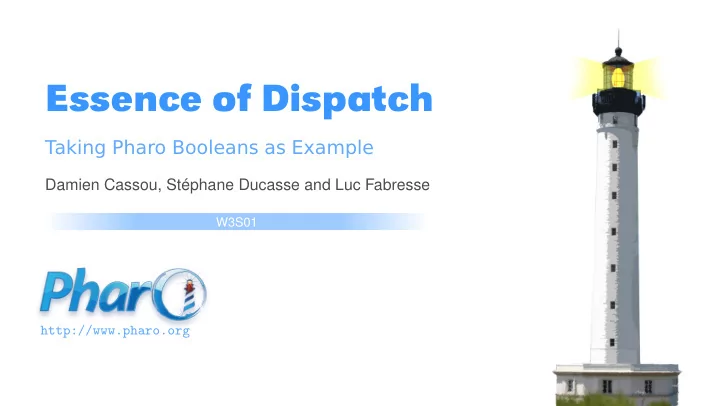

Essence of Dispatch Taking Pharo Booleans as Example Damien Cassou, Stéphane Ducasse and Luc Fabresse W3S01 http://www.pharo.org
Objectives � Understanding of message passing (late binding) ◦ the heart of OOP ◦ more an OOP lecture than a Pharo one � Insight at how beautiful Pharo’s implementation is W3S01 2 / 21
Context: Booleans In Pharo, Booleans have a superb implementation! � & , | , not (eager) � or: , and: (lazy) � ifTrue:ifFalse: , ifFalse:ifTrue: W3S01 3 / 21
Three Exercises 1. Implement not (Not) 2. Implement | (Or) 3. What is the goal of these exercises? W3S01 4 / 21
Exercise 1: Implement Not Propose an implementation of Not in a world where: � You have: true , false � You only have objects and messages � How would you implement the message not ? false not − > true true not − > false W3S01 5 / 21
Hint 1: No conditionals The solution does not use conditionals (i.e., no if ) W3S01 6 / 21
Hint 2: With Three Classes � The solution uses three classes: ◦ Boolean (abstract), True and False � true is the singleton instance of True � false is the singleton instance of False W3S01 7 / 21
Hint 2: Three Classes W3S01 8 / 21
Hint 3: How do We Express Choice in OOP? In OOP , choice is expressed � By defining classes with compatible methods � By sending a message to an instance of such class Example x open � x can be a file, a window, a tool,... � The method is selected based on x ’s class W3S01 9 / 21
Implementation of Not in Two Methods False >> not "Negation −− answer true since the receiver is false." ^ true True >> not "Negation −− answer false since the receiver is true." ^ false W3S01 10 / 21
Implementation Hierarchy W3S01 11 / 21
Message Lookup is Choosing the Right Method W3S01 12 / 21
Boolean Implementation � Boolean is abstract � Subclasses are True and False and implement ◦ logical operations & , not ◦ control structures and: , or: , ifTrue: , ifFalse: , ifTrue:ifFalse: , ifFalse:ifTrue: Boolean>>not "Abstract method. Negation: Answer true if the receiver is false, answer false if the receiver is true." self subclassResponsibility W3S01 13 / 21
Behavior of Or true | true − > true true | false − > true true | anything − > true false | true − > true false | false − > false false | anything − > anything W3S01 14 / 21
Implementation of Or in Boolean Boolean >> | aBoolean "Abstract method. Evaluating Or: Evaluate the argument. Answer true if either the receiver or the argument is true." self subclassResponsibility W3S01 15 / 21
Implementation of Or in Class False false | true − > true false | false − > false false | anything − > anything False >> | aBoolean "Evaluating Or −− answer with the argument, aBoolean." ^ aBoolean W3S01 16 / 21
Implementation of Or in Class True true | true − > true true | false − > true true | anything − > true True >> | aBoolean "Evaluating Or −− answer true since the receiver is true." ^ true W3S01 17 / 21
Real Implementation of Or in Class True The object true is the receiver of the message! True>> | aBoolean "Evaluating disjunction (Or) −− answer true since the receiver is true." ^ true So we can write it like the following: True >> | aBoolean "Evaluating disjunction (Or) −− answer true since the receiver is true." ^ self W3S01 18 / 21
Or Implementation in Two Methods W3S01 19 / 21
Summary � The solution to implement booleans’ operations: ◦ does NOT use conditionals (if) ◦ lets the receiver decide � Do not ask, tell W3S01 20 / 21
A course by and in collaboration with Inria 2016 Except where otherwise noted, this work is licensed under CC BY-NC-ND 3.0 France https://creativecommons.org/licenses/by-nc-nd/3.0/fr/
Recommend
More recommend